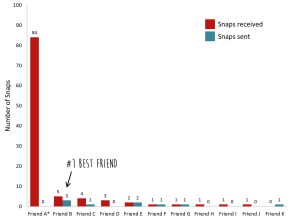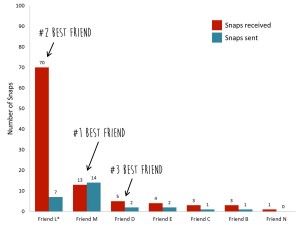Snapchat “Best Friends”
We all know what Snapchat is, but for those who are not very familiar with it, Snapchat is a video messaging application where users can take photos, record videos, add text and drawings, and send them to other users. In this mobile application, there exists a feature which displays your “best friends”. The way your best friends are chosen is influenced by the amount of snaps (pictures/videos) sent to another user and whether they reply or not. Is it a flawed system? This question induced an experiment to answer several questions.
First off, can you be Snapchat Best Friends with someone you’ve never sent a snap to? You cannot because being a best friend requires mutual activity, which the figure below clearly illustrates.
Secondly, can you be Snapchat Best Friends with someone you rarely send snaps to? The answer is yes. Therefore, both factors of sending and receiving snaps are influential in determining your best friends.
The one flaw I see in this system is the course of time it takes to determine a “best friend”. Each graph above represents a week of data. From my own experience in using the application, after a certain period of inactivity, Snapchat seems to start off from a clean slate again in the best friends list. Thus, if you send a few snaps to someone, they almost immediately become your best friend even though they might not be one of your close friends in reality. The person who you’ve sent a few snaps to can replace your previous best friend who you might have interacted with far more in the past. I think Snapchat should take into account everyone you have ever snapped, instead of just recent activity, to improve its accuracy in determining “best friends”.
In relation to the course, Snapchat has this feature where different emojis next to another user’s name represent how close you are to them. There is an emoji with sunglasses, which means you share the same best friend. There is a grimacing face emoji, which means you share the same #1 best friend. There is also a smiling emoji, which means that user is one of your best friends. According to the strong triadic closure property, a link (strong or weak) must exist between two people who each have a strong tie to the same person. Therefore, you should have some sort of connection with the user with a grimacing face emoji. This property is a useful factor in determining best friends, friends and acquaintances in the application.
http://www.mtv.com/news/2073722/snapchat-best-friends-experiment/


